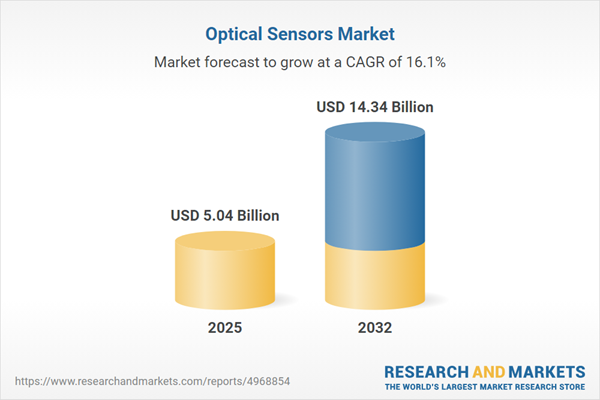Speak directly to the analyst to clarify any post sales queries you may have.
The optical sensors market is rapidly evolving, transforming how industries leverage data for innovation, efficiency, and competitive differentiation. As organizations look to future-proof their operations and respond to global challenges, understanding this market is essential for informed strategic decision-making.
Optical Sensors Market Snapshot
The optical sensors market grew from USD 4.33 billion in 2024 to USD 5.04 billion in 2025. Powered by a projected CAGR of 16.12%, it is set to reach USD 14.34 billion by 2032. Driven by strides in imaging, industrial automation, and advanced defense applications, the industry’s growth is propelled by cross-sector adoption and advances in materials, spectral range, and real-time capabilities. Organizations are leveraging these sensors to enable breakthrough use cases from precision agriculture and environmental monitoring to connected automotive and healthcare systems.
Comprehensive Scope & Segmentation
This research extensively analyzes the global optical sensors industry, detailing all primary market sub-segments and key technology enablers.
- Sensor Type: CCD Image Sensor, CMOS Image Sensor, Fiber Optic Sensor, IR Sensor, Microbolometer, Photodiode
- Sensor Technology: CCD, CMOS, Fiber Optic (Extrinsic, Intrinsic), MEMS (Interferometer, Mirror), Microbolometer
- Interface: Analog Output, Digital Output
- Applications: Aerospace Defense (Navigation, Surveillance, Targeting), Automotive (ADAS, Collision Avoidance, Parking Assistance), Consumer Electronics (Smartphones, Tablets, Wearables), Healthcare (Diagnostics, Medical Imaging, Patient Monitoring), Industrial (Process Control, Quality Inspection, Safety Systems)
- Regions: Americas (United States, Canada, Mexico, Brazil, Argentina, Chile, Colombia, Peru), Europe, Middle East & Africa (UK, Germany, France, Russia, Italy, Spain, Netherlands, Sweden, Poland, Switzerland, UAE, Saudi Arabia, Qatar, Turkey, Israel, South Africa, Nigeria, Egypt, Kenya), Asia-Pacific (China, India, Japan, Australia, South Korea, Indonesia, Thailand, Malaysia, Singapore, Taiwan)
- Company Coverage: Sony Group Corporation, Samsung Electronics Co., Ltd., Hamamatsu Photonics K.K., ams AG, STMicroelectronics N.V., Broadcom Inc., ON Semiconductor Corporation, Texas Instruments Incorporated, TE Connectivity Ltd., Keyence Corporation
Key Takeaways for Senior Decision-Makers
- Integration of AI and machine learning at the sensor level is unlocking real-time analytics and adaptive sensing for autonomous and automated systems.
- Miniaturization, MEMS, metasurfaces, and quantum-dot advances are driving platform innovation, enabling compact, energy-efficient, and high-throughput sensor modules for new industrial and consumer markets.
- Expansion of distributed sensor networks, supported by IoT and next-generation communications, is reshaping deployment strategies and interoperability priorities.
- Regional regulatory priorities, from North America’s reliability demands to EMEA's focus on industrial automation and Asia-Pacific's manufacturing scale, dictate the need for localization strategies and segmented product offerings.
- Strategic partnerships, targeted acquisitions, and vertical integration are transforming the competitive landscape, as organizations seek differentiation through combined hardware, analytics, and connectivity solutions.
Impact of US Tariffs on Global Supply Chains
Newly enacted US tariffs in 2025 are reshaping the optical sensor supply chain. Companies are facing higher procurement and assembly costs, prompting reevaluation of sourcing strategies. Firms are diversifying supplier bases, exploring alternative manufacturing hubs, and leveraging predictive analytics for inventory management to offset regulatory and cost volatility. In parallel, these pressures are motivating upstream integration and accelerated R&D investment to secure critical processes and substitute tariff-sensitive materials.
Research Methodology & Data Sources
This report draws on a mixed-methods approach, combining in-depth engagements with senior industry experts and application specialists for qualitative insight. Comprehensive patent reviews, academic literature analysis, and data modeling—including regression and cluster analysis—ensure a robust quantitative foundation. Vendor segmentation, performance benchmarking, and expert workshops provide data triangulation and validate all strategic findings.
Why This Report Matters
- Offers a granular roadmap for technology adoption, market segmentation, and partnership prioritization tailored for senior leaders.
- Equips organizations to anticipate regulatory, supply chain, and tariff-driven challenges while capturing emerging opportunities in key verticals.
- Supports data-driven investment, innovation, and go-to-market planning rooted in actionable, rigorously validated market intelligence.
Conclusion
The optical sensors market is entering a transformation phase, defined by rapid innovation and new operational complexities. Senior leaders equipped with nuanced, segment-specific intelligence will drive competitive advantage and sustainable growth across this evolving landscape.
Additional Product Information:
- Purchase of this report includes 1 year online access with quarterly updates.
- This report can be updated on request. Please contact our Customer Experience team using the Ask a Question widget on our website.
Table of Contents
3. Executive Summary
4. Market Overview
7. Cumulative Impact of Artificial Intelligence 2025
Companies Mentioned
The companies profiled in this Optical Sensors market report include:- Sony Group Corporation
- Samsung Electronics Co., Ltd.
- Hamamatsu Photonics K.K.
- ams AG
- STMicroelectronics N.V.
- Broadcom Inc.
- ON Semiconductor Corporation
- Texas Instruments Incorporated
- TE Connectivity Ltd.
- Keyence Corporation
Table Information
| Report Attribute | Details |
|---|---|
| No. of Pages | 192 |
| Published | October 2025 |
| Forecast Period | 2025 - 2032 |
| Estimated Market Value ( USD | $ 5.04 Billion |
| Forecasted Market Value ( USD | $ 14.34 Billion |
| Compound Annual Growth Rate | 16.1% |
| Regions Covered | Global |
| No. of Companies Mentioned | 11 |









